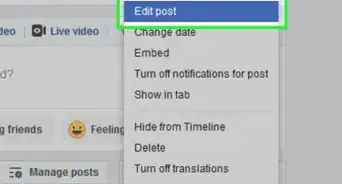This article was co-authored by Christine Michel Carter. Christine Michel Carter is a Global Marketing Expert, Best-Selling Author, and Strategy Consultant for Minority Woman Marketing, LLC. With over 13 years of experience, Christine specializes in strategic business and marketing consulting services including market analysis, organizational alignment, portfolio review, cultural accuracy, and brand and marketing review. She is also a speaker on millennial moms and black consumers. Christine holds a BS in Business Administration and Art History from Stevenson University. She is a leader in multicultural marketing strategy and has written over 100 articles views for several publications, including TIME and Forbes Women. Christine has worked with Fortune 500 clients such as Google, Walmart, and McDonald’s. She has been featured in The New York Times, BBC News, NBC, ABC, Fox, The Washington Post, Business Insider, and Today.
There are 7 references cited in this article, which can be found at the bottom of the page.
This article has been viewed 133,973 times.
We are surrounded by advertising. Whether you’re watching television, reading a magazine, going to the movies, or even browsing social media, you’re bound to see some ads. However, by analyzing what’s included in an ad, such as the language, the imagery, the music, and the actors, you can begin to break down the subtle processes ads use to persuade people to buy certain products and get a sense of how the marketing strategies of advertisers work.[1]
Steps
Breaking Down a Television Commercial
-
1Ascertain who the target audience of the commercial is. Use the context of the commercial (e.g., what channel it’s played on) to figure out who the advertisers are trying to persuade. This will help you determine what sorts of beliefs or emotions the commercial is meant to appeal to.[2]
- For example, if the commercial appears on a TV channel that mainly shows children’s programming, then you can deduce that the advertisers are trying to appeal to children or maybe the parents of young children.
- If you see a commercial in a movie theater, you may be able to determine its target audience based on the nature of the movie. For example, commercials that appear before R-rated movies are probably intended for adult audiences.
-
2Examine how the commercial tries to get your attention. Advertisers want their commercials to be eye-catching as well as persuasive. Look for ways that commercials try to reel you in, such as flashy visuals or special effects.[3]
- How a commercial seeks to grab your attention can also say a lot about its target audience. For example, a commercial that uses explosive special effects may be aimed at teenagers and young adults.
- Advertisers don’t just want their commercial to grab your attention; they also want you to remember it. Consider how their attention-grabbing techniques are meant to stick in your mind and influence your view of a product over the long term.[4]
Advertisement -
3Determine what sort of mood the advertisement seeks to create.[5] The ultimate goal of any commercial is to shape the way you feel about a product or service. Examine the mood of the commercial and how that mood works to shape your feelings towards the commercial’s product.[6]
- For example, a commercial might prominently feature upbeat music, smiling faces, and sunny weather to create a generally happy feeling that you then direct towards the product the commercial is advertising.
- Advertisers will usually try to make commercials that put their product in a positive light. Determining how they go about doing this will also reveal what unspoken beliefs or values the commercial is attempting to appeal to.
-
4Listen to the soundtrack and ask how it affects your reaction.[7] Commercials may use music to subtly influence your emotional reaction to the product being advertised or use a jingle to make the commercial more memorable.[8]
- For instance, may accompany depictions of a generic product with sad music to make you feel that products other than the one being advertised are not as good.
- Ask yourself if your feeling towards the commercial would change if it used a particular genre of music versus another, then think about why different music styles elicit different responses from you.
-
5Consider how the actors chosen to star in the commercial influence you. Advertisers make very deliberate choices when it comes to hiring actors to star in commercials. Examine the age, race, and gender of the actor(s) to determine what sort of response the advertisers are hoping to get from their audience.[9]
- For example, if a commercial pairs a particular beer brand with women in bikinis, the advertisers may be trying to appeal to teenage and adult men through sex appeal.
- Think about why an actor or actors of a certain race or gender were selected, and ask yourself if the perception of the product would change if different actors were used in the commercial. This may indicate certain biases or subconscious motives at work in the ad.
-
6Analyze the language used in the ad. Nearly all commercials feature talking, either from actors starring in the commercial or through a voice-over. Examine the specific words that are featured in the commercial to see how they are being used to appeal to the audience’s emotions.[10]
- If you’re analyzing one or more commercials for a marketing class, you may find that certain words are used more frequently than others. For example, words like “tasty” and “sensational” are commonly used in ads because they tend to make products seem more desirable.
- Pay particular attention to words that aren’t used to directly describe the product, and think about why those words have been included in the commercial. If words aren’t overtly being used to inform the audience, they’re being used to covertly influence viewers.
Evaluating Advertisements in Print Media
-
1Determine who the target audience is for the advertisement.[11] Use the context of the ad (e.g., what type of magazine it’s in) to figure out who the advertisers are trying to persuade. This will help you determine what sorts of beliefs or emotions the ad is meant to appeal to.[12]
- For example, an ad that appears in Cosmopolitan magazine is probably meant to appeal to women, while an ad featured in the newspaper is probably aimed at a wider general audience.
- Think about how a person from a particular demographic might respond to an ad targeted at a different demographic, and why they might have a different reaction. This will help you to determine some of the hidden social meanings that the ad is incorporating.
-
2Examine what action or activity is taking place in the ad. This may be thought of as the advertisement’s “plot” (e.g., a happy family going on a cruise). Consider what sort of significance the ad’s plot has and how it makes you think about the product differently.[13]
- For example, if an ad for a watch features a man wearing it while on a cruise with his family, you may come to associate the watch with the excitement of going on a cruise and the positive feelings of having a family.
- Note that the ad’s plot may not seem relevant to the product itself. This is an example of an advertisement intentionally manipulating their audience’s feelings.
-
3Consider what words are used in the text of the ad. Like with commercials, the words used in print advertisements are meant to either inform about the product or manipulate the audience’s reaction to it. Ask yourself why the particular words in the advertisement were chosen.[14]
- Think as well about how the language in the ad describes the benefits of buying the product. For example, does the ad say the product will make you happier, cooler, or sexier?
- The typeface used is also an intentional design choice. Ask yourself how you might react to the ad if the words were printed in a different typeface and why that might be.[15]
-
4Analyze the images used in the ad. Images are just as important as text in print media advertisements. Take note of what images are used in the ad to depict the product or to complement its depiction.[16]
- For example, ask yourself what sort of images of people or objects are included in the advertisement and how these images influence your reaction to the product. Consider whether your reaction would change if different people or objects were used.
- If you’re analyzing the ad from an artistic perspective, you should also note which colors are used and where in the ad those colors are placed. You may find there are certain colors that are matched with particular emotional responses.
- The ad may feature images that reflect a certain lifestyle (e.g., a two-story home in a wealthy neighborhood) and use these images to associate the product with particular values and beliefs in your mind.
-
5Think about the background and what sort of reaction it’s meant to elicit. Backgrounds are a particularly subtle aspect of how advertisements influence people’s emotions. Pay attention to what sort of background is used in the advertisement and how it might be influencing your reaction to the product.[17]
- For example, a background of a sunny beach and palm tree might be trying to elicit feelings of calm and relaxation, while a busy city street might bring to mind feelings of activity or people in motion.
-
6Take note of how everything in the ad is spatially situated. Print advertisements are limited to a certain amount of space, so the way that advertisers use that space is significant. Think about where words and images in the ad are situated and what reaction that spatial organization is meant to cause.[18]
- For example, an advertisement that seeks to leave its audience excited and energized about its product might feature a large amount of overlapping words and images and leave very little blank space in the ad.
- An ad with lots of empty space might want to make people think of feelings like “quiet” or “understated.”[19]
References
- ↑ Christine Michel Carter. Global Marketing Expert. Expert Interview. 30 September 2020.
- ↑ http://www.classzone.com/cz/books/ml_lit_gr12/resources/pdfs/media_analysis/HS_15_Ad_Techniques2.pdf
- ↑ http://www.understandmedia.com/topics/media-theory/110-how-to-analyze-a-television-commercial
- ↑ https://www.forbes.com/sites/marketshare/2012/10/19/what-makes-a-tv-commercial-memorable-and-effective/#4dc553633079
- ↑ Christine Michel Carter. Global Marketing Expert. Expert Interview. 30 September 2020.
- ↑ http://www.understandmedia.com/topics/media-theory/110-how-to-analyze-a-television-commercial
- ↑ Christine Michel Carter. Global Marketing Expert. Expert Interview. 30 September 2020.
- ↑ https://www.forbes.com/sites/marketshare/2012/10/19/what-makes-a-tv-commercial-memorable-and-effective/#4dc553633079
- ↑ http://www.understandmedia.com/topics/media-theory/110-how-to-analyze-a-television-commercial
- ↑ http://www.classzone.com/cz/books/ml_lit_gr12/resources/pdfs/media_analysis/HS_15_Ad_Techniques2.pdf
- ↑ Christine Michel Carter. Global Marketing Expert. Expert Interview. 30 September 2020.
- ↑ http://www.understandmedia.com/topics/media-theory/108-how-to-analyze-a-print-advertisement
- ↑ http://www.medialit.org/reading-room/how-analyze-advertisement
- ↑ http://www.understandmedia.com/topics/media-theory/108-how-to-analyze-a-print-advertisement
- ↑ http://www.medialit.org/reading-room/how-analyze-advertisement
- ↑ http://www.understandmedia.com/topics/media-theory/108-how-to-analyze-a-print-advertisement
- ↑ http://www.medialit.org/reading-room/how-analyze-advertisement
- ↑ http://www.medialit.org/reading-room/how-analyze-advertisement
- ↑ http://www5.csudh.edu/ccauthen/350S12/ad-questions3.htm
About This Article
Advertisements are all around you, and once you know what to look for, you can analyze them to see how they work. Every ad is designed for a specific target audience, like children, young professionals, or women. An ad for children might use bright colors and big text, while an ad for young adults might feature twenty-something models. The goal of an ad is to grab its target audience's attention and make them feel or want something. Some ads might use flashy visual effects to draw people in, while others will rely on happy or sad music to play on people's emotions. If an ad has a famous person in it, the company that made the ad is probably trying to influence that celebrity's fan base to buy their products. The main thing to consider when looking at any ad is how all of the different elements are being used to sell you something. For more tips, including how to analyze TV commercials, read on!









































































